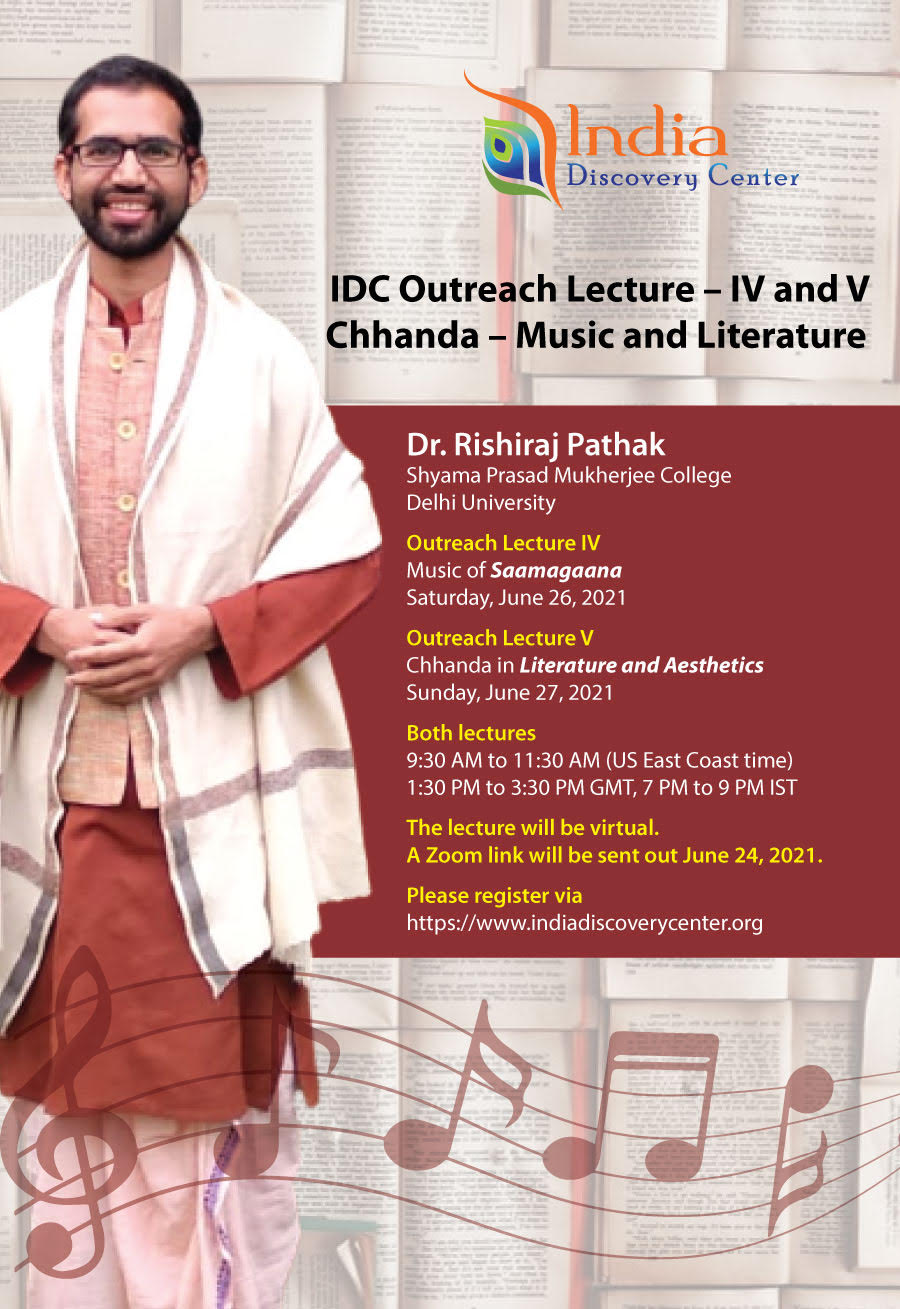
Outreach Lectures IV and V – Chhandas – Music and Literature
Presenter
Dr. Rishiraj Pathak
Teaching Faculty,
Dr. Shyama Prasad Mukerji College, New Delhi
Dr. Rishiraj Pathak
Dr. Rishiraj Pathak is a rare young talent who has immersed himself in exploring the old traditions of Indian music through scholarly work and personal practice. Trained in literature and music at home, he has attended and has been associated with major music and traditional literary institutions in India to cultivate his passion on Indian vocal music and literature. Currently he serves in the Faculty of Delhi University teaching at Shyama Prasad Mukherji College. He is a sought- after performer to demonstrate the Indian vocal tradition in media, festivals and in literary-cultural assemblies.
Dr Pathak has been profusely rewarded for his work and industry. He is a published author with two poetry texts named Ādyonmeṣaḥ (2016) and śrīmadūdhamasiṁhacaritam (2019) published by Devavani Parishad, Delhi. He has edited four sections śrīhīrakaprābhṛtam and five sections of Nārāyaṇa-racanāvalī. More than thirty of his research papers and articles have been published in scholarly journals. His articles on ‘Vedādhyayana ke vibhinna pāṭha-prakāra’, a comprehensive study on the various traditions of Vedic Studies and ‘Sāmaveda-śikṣaṇa meṁ kūṭākṣara’, a decoding text of the code letters used in Sāmaveda learning, are some the most cited entries in the ‘Mind, Morality and Motives : Learnings from Indian Traditions’ a Responsive Research Project undertaken by the Indian Council for Social Sciences Research under the Ministry of Human Resource Development.
Dr. Pathak has composed various original compositions in Sanskrit, Hindi and Brajbhasha for different Indian classical dance forms. Some of these are – Svadeśaṁ bhajāmaḥ – Vocal for local (Smt. Vani Madhav, Odissi : Nritya Dhara, Gurugram), Prārthanā (Shri Sanjib Bhattacharya, Manipuri : Hritaal Dance Centre, Kolkata, West Bengal), Candrapraveśam (Payal Ramchandani, Kuchipudi : Bloomsbury Festival, London, UK), Ritusatram, (Smt. Nandini Mandal, Bharatnatyam : Pittsburgh, Pennsylvania, US).
IDC Outreach Lecture IV
June 26, 2021, 9:30 AM (US EST, 7 PM IST)
Music of Sāmagāna
Sāmagāna, the oral recitation of Sāmaveda, is alive from the ancient times through the family lineage. There are different branches of Sāmagāna along with a variety of singing styles. Svara, Śruti, Mātrā, Saptaka, Laya and Stobha etc.. We find varied accents, for instance udātta, anudātta and svarita in Arcika Svara, and Kruṣṭa, Prathama, Dvitiya, Tṛtiya, Caturtha, Mandra and Atisvārya in Gāna svara. There is a special relation of these svara with Ṣadja, Ṛṣabha, Gāndhāra, Madhyama, Pañcama, Dhaivata and Niṣada (sā re ga ma pa dha ni). Śrutis are also used in Sāmagāna viz. Dīptā, Āyatā, Karuṇā, Madhyamā and Mṛdu. There is a specific recitation of the Śrutis. Apart from this, Sāmgāna is famous in three verses – Auḍava, Ṣāḍava and Sampūrṇa. The use of the musical instruments, Vīṇā and Veṇu had been in use since ancient times. According to Nānyadeva, Tāna was used in Sāmagāna, which has lost usage today. Vṛndagāna (group recitation) with singers in Udgātā, Prastotā, Pratihartā and Subhrahmaṇya. Stobha were used. The tarānā in modern Indian music is based on this tradition. The evolution of Rāgas can be attributed to Sāmagāna. The presentation of Sāmagāna is done by Hastavīṇā and the evolution of ‘staff notation’ is attributed to Hastavīṇā. The influence of Sāmagāna on ancient Western music is evident through the religious paeans.
IDC Outreach Lecture V
June 27, 2021, 9:30 AM (US EST, 7 PM IST)
Chhanda in Literature and Aesthetics
In the Indian tradition, the Chhandas have been counted as one of the six vedāṅga. They are useful in the presentation of Vedic chanting and interpreting the meaning. These are divided in terms of varṇa and mātrā. From this point of view these can also be divided into a rhyming and rhymeless form. In Sanskrit poetry, chhandas have been used to reveal the rasa and bhāva of the story. The application of Chhandas in conveying message is elegantly visible in the traditional poetry of Ravana, Bhasa, Kalidasa, Shankaracharya, Jayadeva, and many modern poets like Ramakant Shukla, Abhiraj Rajendra Mishra, Radhavallabh Tripathi, Ichharam Dwivedi, Paramanand Jha, etc. Presenting the verses in classical ragas and talas appropriate to their rasa and expressions, the inner expression comes to life. Lately, some of the laukika chhandas are being imported from vernacular languages to Sanskrit. Alternatively, many Sanskrit meters are finding place in the movie music. We discuss the topics by exhibiting the association of the chhandas to the literature excerpts by vocally rendering them through.